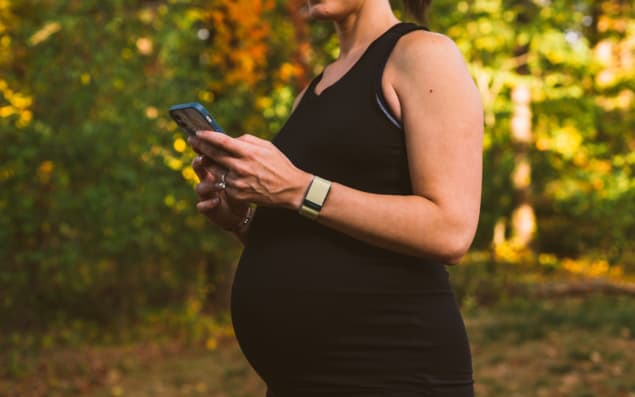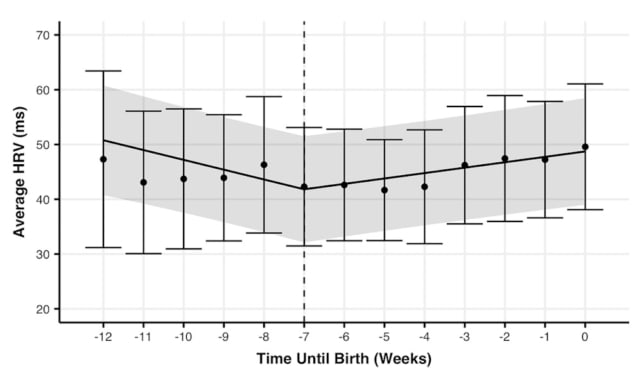
Preterm birth – when a baby is born before the 37th week of pregnancy – can result in considerable health and development problems. Identifying the risk of premature delivery could enable interventions to delay labour onset or treatments to improve respiratory and nervous system function at birth. But preterm birth is difficult to predict: few screening options exist and those that do are used infrequently.
To overcome these limitations, researchers from wearables specialist WHOOP and West Virginia University have investigated whether maternal heart rate variability (HRV) measured using the WHOOP strap could provide a digital biomarker for preterm birth. The WHOOP strap is a commercial wearable device that continuously monitors a range of physiological parameters, including HRV, the fluctuation in the time intervals between consecutive heartbeats.
“We chose [to examine] heart rate variability because it is a non-invasive and reliable indicator of the autonomic nervous system’s activity,” explains Emily Capodilupo, senior vice-president, data science and research at WHOOP.
In previous research by Shon Rowan and colleagues at West Virginia University, data from the WHOOP strap revealed that maternal HRV steadily decreased during pregnancy until approximately 33 weeks of gestation, at which point it started to increase. This work, however, only included pregnancies delivered at term.
The latest study, led by Capodilupo and described in PLoS ONE, examined both term and preterm pregnancies. The aim was to determine whether the same trends in maternal HRV were observed, and whether the HRV inflection point is an indication of time to delivery or simply a feature of gestational age.
The study cohort included 241 women who gave birth between March 2021 and October 2022, with 220 term and 21 preterm births. All women wore a WHOOP strap during their pregnancy and recorded a mean of 99.9 (±19.3) days of data from week 24 until the birth. For each participant, the researchers derived daily HRV values by averaging measurements taken at 30 s intervals throughout the night. They then analysed weekly averages to capture trends over time and assess changes in HRV relative to the eventual delivery date.

After splitting the subjects into preterm and term groups, they analysed the mean weekly HRV data using two mixed-effect spline models: the first relating HRV to gestational age (from week 24 until the reported date of birth); and the second relating HRV to weeks until birth (from the birth date backward until week 24). Data for each group were fit to a linear spline model with a knot (the point of inflection between two linear fits) at either 33 gestational weeks or seven weeks from birth, for the first and second models, respectively.
While trends in HRV were associated with both gestational age and weeks until birth, the researchers found that for both term and preterm pregnancies, the maternal HRV inflection was more strongly correlated with weeks until birth. They suggest that monitoring changes in nightly maternal HRV could help detect an increased risk of preterm delivery, flagging the need for further tests and medical interventions where required.
“Our study found maternal HRV trends inverted seven weeks before delivery, which means that monitoring for that inversion could potentially provide early indication of a probable delivery date,” says Capodilupo.
Continuous monitoring using a non-invasive wearable device could prove particularly important for pregnant women in medically underserved areas, where premature births have comparatively worse outcomes. Knowledge of the likely delivery date may help women access a properly equipped delivery facility in a timely fashion.

Deep learning teases apart abdominal ECG signals
The researchers note, however, that the current dataset is underpowered for individual-level predictions, as the data analysis was conducted using average values from women in each group. “While [our results] provide insights at the group level, further research with a larger dataset would be required to individually assess the utility of watching for an inflection point,” Capodilupo explains.
With this in mind, the team is now undertaking a larger investigation into the value of HRV for predicting preterm birth. “This study suggests that further research is warranted to better understand this phenomenon at an individual level and the extent to which the timing of an inflection point in maternal vital signs predicts future preterm birth,” Capodilupo tells Physics World.
- SEO Powered Content & PR Distribution. Get Amplified Today.
- PlatoData.Network Vertical Generative Ai. Empower Yourself. Access Here.
- PlatoAiStream. Web3 Intelligence. Knowledge Amplified. Access Here.
- PlatoESG. Carbon, CleanTech, Energy, Environment, Solar, Waste Management. Access Here.
- PlatoHealth. Biotech and Clinical Trials Intelligence. Access Here.
- Source: https://physicsworld.com/a/wearable-device-could-help-predict-preterm-birth/



